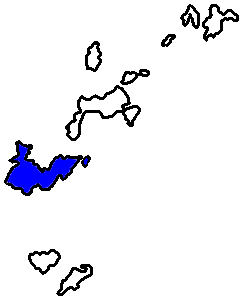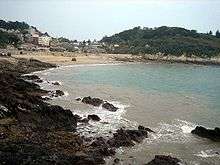Nangan, Lienchiang
| Nangan 南竿鄉 | |
|---|---|
| Rural Township | |
| Nangan Township | |
|
Vegetable Farming Park | |
 Nangan Township in Lienchiang County | |
 Nangan Location in the Republic of China | |
| Coordinates: 26°09′N 119°56′E / 26.150°N 119.933°ECoordinates: 26°09′N 119°56′E / 26.150°N 119.933°E | |
| Country | Republic of China |
| County | Lienchiang County |
| Area | |
| • Total | 10.40 km2 (4.02 sq mi) |
| Population (Dec. 2014) | |
| • Total | 7,496 |
| • Density | 720/km2 (1,900/sq mi) |
| Postal code | 209 |
| Area code(s) | (0)836 |
| Website | http://www.nankan.gov.tw/ |
| Nangan, Lienchiang | |||||||||||||
| Traditional Chinese | 南竿鄉 | ||||||||||||
|---|---|---|---|---|---|---|---|---|---|---|---|---|---|
| Simplified Chinese | 南竿乡 | ||||||||||||
| |||||||||||||
Nangan Township (Chinese: 南竿鄉) is a township in the Matsu Islands and the county seat of Lienchiang County, Taiwan.[1]
Nangan was also known Nangantang (南竿塘; Nàng-găng-dòng) and Shanggantang (上竿塘). And because Lin Moniang's (who later became the goddess Matsu) corpse was washed ashore here, Nangan was also known as Matsu Island (馬祖島; Mā-cū-dō̤).
There is an airport in Nangan. The highest point is Yuntai Mountain (雲台山) (248-metre).
Geography
The island of Nangan is not only the largest island of its township, but also the largest island of Matsu. Nangan Township is also the largest township in Lienchiang County, with a population of about 4,000. The highest point of the island is the Yuntai Hill peak at 250m. Nangan's climate is classified as subtropical, with distinct seasons. The average year-round temperature is 20C, with July and August reaching 34C and January temperatures as low as 1.8C. There is an intense fog period during March and April which often affects the scheduled flights at Nangan Airport.
Administration


There are 10 villages located on Nangan. At the eastern end of the island is Jieshou (介壽村), the seat of the county government and the largest village. Following the coastal road west from Jieshou, there are Fuxing (復興村), Fuao (福澳村), Qingshui (清水村), Zhuluo (珠螺村) and Mazu (馬祖村). Following the mountain road west, there are Meishi (梅石村), Renai (仁愛村) and Jinsha (津沙聚落), before once again reaching Mazu. Located to the north of Mazu is Siwei (四維村). In addition to these, there are two smaller villages or clusters of homes. These are Furen (夫人村) and Ketiao (科蹄澳), they are located near Siwei.
Many villages on Nangan have two names. In some cases, this was the result of politics, as one is the traditional name and the second has a political connotation. These instances are paired as follows with the traditional name first: Shanlong (山隴): Jieshou (介壽), Niujiao (牛角(聚落)): Fuxing (復興), Tieban (鐵板): Renai (仁愛), and Fuao (福澳): Jingze (經澤). These names are often used interchangeably by residents, except for Jingze. Residents objected to this latter name, and so it never came into popular use. The reference to Shanlong is also important as there is a neighborhood there called Zhonglong (中隴). Mazu is also referred to as Magang (馬港) and Siwei as Xiwei (西尾). As for Mazu and Magang, Magang is the preferred name. This could be in order to distinguish the village and its harbor from Mazu (媽祖), the goddess, and Mazu (馬祖) the island chain. Xiwei was derived from the local Fuzhou dialect's pronunciation of Siwei.
- Jieshou (Chinese: 介壽村; pinyin: Jièshòu) literally, "Longevity for Chiang Kai-shek "
- Jinsha (Chinese: 津沙村; pinyin: Jīnshā) "Sand of Seaport"
- Cingshuei (Chinese: 清水村; pinyin: Qīngshuǐ) "Pure Water"
- Jhuluo (Chinese: 珠螺村; pinyin: Zhūluó) "Pearl and Snail"
- Fusing (Chinese: 復興村; pinyin: Fùxīng) "Revive Prosperity"
- Fuwo (Chinese: 福沃村; pinyin: Fúwò) "Auspicious Fertility": Jingze Village (經澤)
- Ren-ai (Chinese: 仁愛村; pinyin: Rénài) "Humanity and Love": Tieban (鐵板 "Iron Plate") until 1955 .
- Matsu (Chinese: 馬祖村; pinyin: Mǎzǔ) "Matsu"
- Sihwei (Chinese: 四維村; pinyin: Sìwéi) "Four Virtues"
Government institutions
Tourism

The Palace of Heavenly Empress (天后宮) in Matsu Village contains the coffin of Lin Moniang. The temple also contains statues of the guards, Thousand-li Eye (千里眼) and Wind-following Ear (順風耳). There is an annual celebration on March 3.
Matsu Distillery (馬祖酒廠) on Wujiao Hill (午角嶺) in Fusing Village produces daqu wine (大麴酒) and sorghum wine (高梁酒).
Shengli Water Reservoir (勝利水庫 "Victory") and a museum are located in Cingshuei Village. The museum contains four cannons from Jyuguang which were used to guide boats. Another museum is the Matsu Folk Culture Museum in Jieshou Park.
There are two abandoned military tunnels on the island: Eighty-eight Tunnel (八八坑道) and Beihai Tunnel.
Infrastructure
Transportation
- Uni Air is the only airline serving the island, with eight flights a day to Nangan Airport and three flights a day to Beigan Airport. All of the above flights arrive at Songshan Airport in Taipei with the exception of one flight at Taichung Airport in Taichung.
- Commercial boat rides are provided hourly every day from 7am to 5pm. The rides take approximately 10 minutes to Beigan.
- Commercial boat rides to Juguang island takes approximately an hour with three rides a day.
- There are ferryboat scheduled on a weekly basis between Keelung Port and Nangan's Fuao Harbor.
Notable natives
- Yang Sui-sheng, former Magistrate of Lienchiang County
See also
| Wikimedia Commons has media related to Nangan, Lienchiang. |
References
- ↑ "Nangan - Matsu National Scenic Area". Matsu-nsa.gov.tw. 2012-08-13. Retrieved 2014-04-23.
External links
- Matsu National Scenic Area - Nangan
- 12 photos
- Nangan, Lienchiang, Taiwan, Republic of China .

